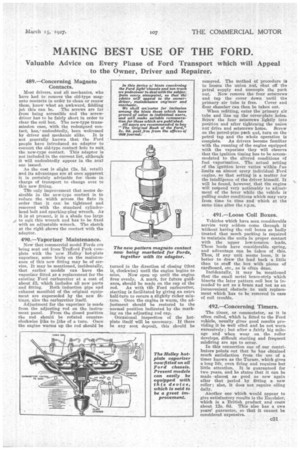MAKING BEST USE OF THE FORD.
Page 53

If you've noticed an error in this article please click here to report it so we can fix it.
Valuable Advice on Every Phase of Ford Transport which will Appeal to the Owner, Driver and Repairer.
• 489.—Concerning Magneto Contacts.
Most drivers, and all mechanics, who have had to remove the old-type magneto contacts in order to clean Or renew them, know what an awkward, fiddling job this can be. The screws are far from being accessible and the screwdriver has to be fairly short in order to clear the coil box. The new-type transmission case, with the redesigned contact, has,' undoubtedly, been 'welcomed
by driver and mechanic alike. It is not generally known that the Ford people have introduced an adaptor to convert the old-type contact hole to suit the new-type contact. This adaptor is not included in the current list, although it will undoubtedly appear in the next one issued.
• As the cost is slight (2s. 8d. retail) and its advantages are at once apparent it is certainly advisable for thoSe in charge of transport to change over to this new fitting.
Tile only improvement that seems desirable in the new-type contact is to reduce the width across the flats in order that it can be tightened and removed with the standard cylinderhead bolt and sparking-plug wrench. As it is at present, it is a shade too large J to suit this wrench and has to he fixed with an adjustable wrench. The sketch at the right shows the contact with the adaptor.
490.—Vaporizer Maintenance.
Now that commercial model Fords are being sent out from Trafford Park complete with the new Holley hot-plate vaporizer, some hints on the maintenance of this new fitting may be of service. It may be mentioned, incidentally, that earlier models can have the vaporizer fitted as a replacement for the existing Ford carburetter at a cost of about £3, which includes all new parts and fitting. Both induction pipe and exhaust manifold of the original equipment are superseded by the new fittings, also the carburetter itself.
Adjustment for the vaporizer is made from the adjusting rod on the instrument panel. From the closed position the rod should be rotated counterclockwise Iths to Iths of a turn. Once the engine warms up the rod should be
turned in the direction of closing (that is, clockwise) until the engine begins to miss. Now open up until the engine fires evenly. A mark, for future guidance, should be made on the cap of the rod. AS with tlie Ford carburetter, starting is facilitated by giving an extra half-turn to secure a slightly richer mixture. Once the engine is warm, the adjustment should be restored to the normal position indicated by -the marking on the adjusting rod cap.
Occasional inspection of the hotplate itself will be necessary. If there be any soot deposit, this should be removed. The method of procedure is to loosen the union nut, shut off the petrol supply and uncouple the pack nut. Now remove the four setscrews and tap the cover down until the primary air tube is free. Cover and float chamber can then be taken out.
When refitting, enter the primary air. tube and line up the cover-plate holes. Screw the four setscrews lightly into position and after tightening the union nut drive and setscrews home. Screw on the petrol-pipe pack nut, turn on the petrol tap and the whole operation is complete. As drivers become familiar with the running of the engine equipped with the vaporizer they will observe that the ignition timing has to be accommodated to the altered conditions of fuel vaporization. The actual setting of the ignition lever varies within f ne limits on almost every individual Ford engine, so that setting. is a matter for the intelligence of the driver himself. It will be found, however, that the engine will respond very noticeably to adjustment of the lever while the vehicle is pulling under conditions which may vary from time to time and which at the same time alter the r.p.m.
491.—Loose Coil Boxes.
Vehicles which have seen considerable service very seldom come through it Without having the coil boxes so badly treated that much packing is required to maintain the units in proper contact with the upper low-tension leads. These leads have considerable spring, and advantage can be taken of this. Thus, if any unit seems loose, it is better to draw the Toad back a little than to stuff the box with pieces of cardboard, etc., as is often done.
Incidentally, it may be mentioned that the small metal brace-strip which bisects the later pattern coil box is intended to act as a brace and not as an inconvenient obstacle to unit replacement which has to be removed in case of coil trouble.
492.—Concerning Timers.
The timer, or commutator, as it is often called, which is fitted to the Ford vehicle, usually gives good results providing it be Well oiled and be not worn excessively; but after a fairly big mileage and when wear on the roller develops, difficult starting and frequent misfiring are apt to occur.
In this connection one of our contributors points out that he has obtained much satisfaction from the use of a timer known as the Turner, which gives a long life, even firing and requires but little attention. It is guaranteed for two .years, and he states that it can be made almost as good as new again after that period by fitting a new roller ; also, it does not require oiling daily.
Another one which would appear to give satisfactory results is the Excelsior, which is a British product and costs about 12s. 6d. This also has a two years' guarantee, so that it cannot be considered expensive.












































































































